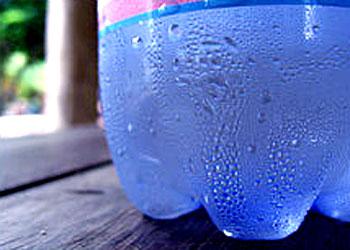 Water is boiling to form steam (which is a gas). The heat required for the boiling of water is being supplied by a burner.
Water is boiling to form steam (which is a gas). The heat required for the boiling of water is being supplied by a burner.
The distance between neighboring atoms or molecules in a substance decides how tightly the binding is. In comparison, in a liquid the binding is not very strong. In a gaseous state the binding is even weaker.
Boiling point of the liquid:
The process in which a liquid substance changes into a gas rapidly on heating,
is called as boiling. Upon heating, water changes into steam rapidly, it is
called as boiling of water. The temperature, at which a liquid boils and
changes rapidly into a gas at atmospheric pressure, is called boiling point
of the liquid.
For example, when water is heated to a temperature of 100°C, it boils rapidly to form a gas called steam, so the boiling point of water is 100°C. At boiling point, water changes its state from liquid to gas (or vapor).
The boiling point of a liquid is a measure of the forces of attraction between its particles. Higher the boiling point of a liquid, greater will be the forces of attraction between its particles. The boiling point of mercury is very high (357°C) which tells us that the forces of attraction between the particles of mercury are very strong.
Different liquids have different boiling points
| LIQUID | BOILING POINT |
|---|---|
| ALCOHOL | 78°C |
| WATER | 100°C |
| MERCURY | 357°C |
 Water vapor condenses into a liquid after making contact with the surface of a cold bottle.
Water vapor condenses into a liquid after making contact with the surface of a cold bottle.
Changes In States Of Matter:
- Solid to liquid conversion (Melting): If we heat ice, it changes into water. In this case, solid ice changes into liquid water, so a change of state has taken place. The process, in which a solid substance changes into a liquid on heating, is called melting (or fusion).
- Liquid to gas conversion (Boiling or Vaporization): Water normally exists in the liquid state. As we go on heating water, it ultimately starts boiling and converts into a gas which is termed as steam.
- Gas to liquid conversion (Condensation): If we cool steam (or water vapor) by lowering its temperature, it is converted into liquid water. The process of converting a gas to a liquid, by cooling is called condensation. Condensation is reverse of boiling (or vaporization).
- Liquid to solid conversion (Freezing): Freezing is the reverse process of melting. When water is cooled (by lowering its temperature by keeping in the freezer compartment of a refrigerator), it changes into solid ‘ice’. The process of conversion of a liquid into a solid by cooling is called freezing.